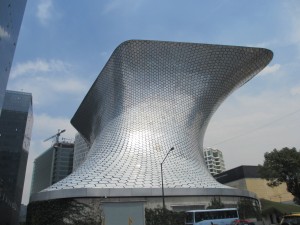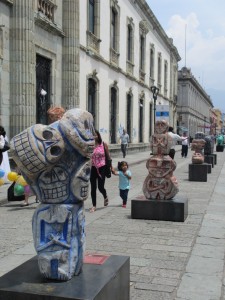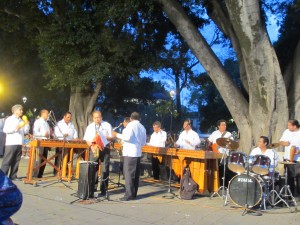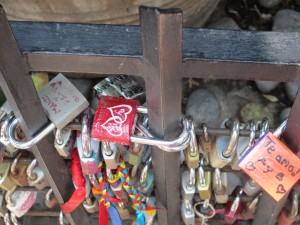After last week’s column about Mexico, a close friend pointed out that Sue and I had been in Mexico as tourists (true) and, as such, saw the best face of the country (also true). Went on to express her admiration of Mexican peoples’ working and family ethos. Then added that Mexico’s judicial system is based upon “guilty until proven innocent,” something that is radically different (unless you’re a person of color in the US) than our own “innocent until proven guilty.” I immediately searched Google. Evidently, in June 2008 Mexico’s President, Felipe Calderon, signed a law of national reforms of both federal and state level justice systems which included the presumption of innocence and a defendant’s right to a public trial. The entire series of reforms are to be completely implemented throughout the country by 2016. Also, my friend neglected to mention that Mexico has no death penalty, an attitude a hell of a lot more civilized than here.
She also wrote about the high level of violence due to drug cartels and named a number of areas that included a high proportion of border towns. Absolutely true and horrible for ANYWHERE, but here’s the rub. Cartels in Mexico control approximately 70% of the foreign narcotics that flow into the United States which includes, according to the US State Department estimates, 90% of the cocaine that enters our country. Let’s get real here, we’re the cartels’ consumers. How about a sane drug policy that would significantly reduce the associated violence both in Mexico and the United States?
But these columns were never intended to bite into Mexico’s social structure, legal system, immigration issues, or violence—as real as they are. We were tourists and my hope is simply to present facets of our neighbor most Americans never get to see. Believe me, there will be plenty of political posts from this seat. Just not today.
 We chose to visit Oaxaca because Sue had been there a number of times (long ago) and thought I’d love the town, people, and its amazing history. Luckily we ended up with a high octane dose of all these things by chance. Turns out we visited Oaxaca City during the highlight week of the State’s 482nd birthday. With huge posters announcing their “Cultural Blockade,” streets were closed to cars to allow for a multitude of events including public story-telling,
We chose to visit Oaxaca because Sue had been there a number of times (long ago) and thought I’d love the town, people, and its amazing history. Luckily we ended up with a high octane dose of all these things by chance. Turns out we visited Oaxaca City during the highlight week of the State’s 482nd birthday. With huge posters announcing their “Cultural Blockade,” streets were closed to cars to allow for a multitude of events including public story-telling,
We had stumbled into an amazing 24/7 party where entire families, from infants to grandparents, participated together. No spring chickens, even we realized that 482 years is something to celebrate. And so we did.
 While the festival was an incredible rush, it was Oaxaca State’s complex history that was truly an eye-opener. Three millennia before the 1521 Spanish invasion, this region contained about16 different ethnic groups, each with its own language, culture, and traditions. Monte Alban had been inhabited over 1,500 years by a succession of peoples—Olmecs, Zapotecs, and Mixtecs and served as the Zapotec capital for thirteen centuries. Tough to swallow but Monte Alban was a city of 40 to 50 thousand people that, for no known reason, was abandoned beginning around 850 A.D. No known reason. That’s one long term head-scratcher. Now Monte Alban along with Mitla (the second largest city in Oaxaca during the Zapotec heyday) are two of Mexico’s most famous archeological ruins.
While the festival was an incredible rush, it was Oaxaca State’s complex history that was truly an eye-opener. Three millennia before the 1521 Spanish invasion, this region contained about16 different ethnic groups, each with its own language, culture, and traditions. Monte Alban had been inhabited over 1,500 years by a succession of peoples—Olmecs, Zapotecs, and Mixtecs and served as the Zapotec capital for thirteen centuries. Tough to swallow but Monte Alban was a city of 40 to 50 thousand people that, for no known reason, was abandoned beginning around 850 A.D. No known reason. That’s one long term head-scratcher. Now Monte Alban along with Mitla (the second largest city in Oaxaca during the Zapotec heyday) are two of Mexico’s most famous archeological ruins.
The Aztec capital of Gran Tenochtitlan — (which eventually became Mexico City) — fell in 1521 to Hernan Cortes of Spain. After the fall of the Aztecs, Oaxacan Zapotecs attempted alliances with the Spaniards. Instead Spain set out to conquer Oaxaca and grab all the gold and silver in its mountains–a shitload of money in them thar hills. But  the Oaxacan peoples were conquered, not by Spanish arms and soldiers, but by religious psychological warfare and an army of priests and friars. In 1560, the Dominicans reported that the natives were converted, completely docile and submissive.
the Oaxacan peoples were conquered, not by Spanish arms and soldiers, but by religious psychological warfare and an army of priests and friars. In 1560, the Dominicans reported that the natives were converted, completely docile and submissive.
Or dead. It’s estimated that in 1519 when Cortes arrived the population of Mesoamerica was around 25,000,000 people. By 1605 75% to 90% were gone—primarily to European diseases against which the natives had no immunity. A pretty grim annihilation.
We spent eight days in Oaxaca City and barely scratched its surface but I’d be remiss if I didn’t mention that two of its most famous products are many different types of mole and a particular type of black pottery.
The last part of our trip was four days in Mexico City. Since we’d been there before and had visited most of the major tourist  sights and museums, we decided to stay at a small hotel located between two interesting neighborhoods—La Condesa and Roma. Although recently known to be artsy, the architecture is an incredible mix of Art Nouveau, Art Deco, and modern. (This mix is partly due to earthquakes which destroyed some buildings and left others standing so the rebuild created a mélange.) In fact, one of Mexico City’s most famous Nouveau buildings is located in Roma.
sights and museums, we decided to stay at a small hotel located between two interesting neighborhoods—La Condesa and Roma. Although recently known to be artsy, the architecture is an incredible mix of Art Nouveau, Art Deco, and modern. (This mix is partly due to earthquakes which destroyed some buildings and left others standing so the rebuild created a mélange.) In fact, one of Mexico City’s most famous Nouveau buildings is located in Roma.
There are many art galleries in the two neighborhoods and we found one small museum that was presenting an exhibit of artifacts donated by individuals that represented their broken relationships, along with the person’s accompanying story. 
As if in contrast to the exhibit, on the sidewalk outside the museum, people kept putting locks proclaiming their love for each other on iron fences.
There were a ton of hidden treasures in both neighborhoods and, despite one trip outside to the city’s new modern art museum, Museo Soumaya, after four days there was still more to see in these two neighborhoods; restaurants, parks, and walks.
and, despite one trip outside to the city’s new modern art museum, Museo Soumaya, after four days there was still more to see in these two neighborhoods; restaurants, parks, and walks.
I’m an urban guy with concrete in my blood so cities fascinate me. And Mexico City sits right up there with Paris (my favorite), New York, and San Francisco.
I’ll end this piece where I began. I know there’s an ugly underside to Mexico. An ugly underside to every country, really, and I hate those horrors. But there are times to grab hold of life’s pleasures, and some of life’s greatest pleasures exist south of our border. I just wish everyone had a chance to enjoy them.
The world is like that — incomprehensible and full of surprises~Jorge Amado









Thank you for taking me into a world I may never see with my own eyes. I especially flipped over the beautiful black pottery. I’m glad that you began the article with the opening you chose.
Kathleen–The pottery is amazing. Had a hell of a time getting some home without breaking them. Thanks for taking the time to read and comment. Always appreciated!
I’m with you. If 20 or 30 thousand people once lived in Monte Alban *where did they all go and why*?
I suppose there are the usual suspects–war (economic, religious, revolutionary, civil), possible earthquake swarms that terrified everyone, and very possibly a decades-long drought that starved them all out. You didn’t mention any nearby volcanoes, but Mexico has a long history of active volcanoes powerful enough to cast darkness over the land for days and ruin crops for thousands of square miles.
Then there’s the old History Channel prospect of huge flying saucers landing and their spokesman leaving behind a book titled, “To Serve Man.” But let’s ignore that for just now.
Every so often I run across a book that I’m so moved by that I think it should be required reading in high schools. One such book is “The Great Influenza” by John M. Barry. It’s a great detective story, a fascinating look at modern medicine just before the age of antibiotics (which wouldn’t have helped them anyway), an explanation of how rampant super-patriotism in WW 1 actually spread the disease as fast as possible, and an utterly staggering view of what that disease did to the entire world. A figure of 20 million to 50 million is generally given as the “Spanish Flu’s” death toll. Barry shows quite easily that the number was probably closer to 100 million.
And there was nothing Spanish about that strain of flu at all. It originated in the United States. The leap in mutant flu viruses took place, most likely, in Kansas.
In chapter after chapter, he describes the sheer terror of both medical professionals and everyday citizen seeing loved ones, neighbors, friends, family members, and massive groups of total strangers cut down by an invisible killer. Some lingered for days. Some were laughing and telling jokes at lunchtime and were dead before midnight. He gives many accounts of eyewitnesses stating they saw healthy-looking people simply keel over dead on sidewalks, street cars, and in theaters. They were using steam shovels in American cities because there were too many dying each day for proper burials. They simply dug huge pits and filled them with the dead. And then had to begin digging other pits.
In trying to explain what death on such a scale does to the minds of the survivors, Barry reached back into history and gave examples of the contemporary writings of Romans during the Plague of Justinian, various plagues that swept India and Asia, and of course The Black Death–the bubonic plague–of Europe in the 1340’s.
Kent–The disappearance of maybe 50,000 people with literally no “hand me down stories” true or not blows my mind. Makes me wonder how many other large numbers of people have disappeared. As far as the “Spanish Flu” goes, the only thing i do know is they brought whatever it was to Mesoamerica.
As I wrote you, I accidentally hit “send” before finishing that post. Sorry.
But I was trying to point out what sheer, long-term terror can do to human minds.
Monte Alban was deserted for reasons unknown. Since its taller buildings and spires still stand, we can rule out earthquakes. If it had been buried–like Pompey and Herculaneum–by volcanic eruption, or even if a volcano had dropped several feet of ash on them, ruining their crops for years and starving them out, there would not only be verbal histories of that but plenty of remaining evidence.
You say there are no verbal or written histories of invading armies or war. To me this just leaves two possibilities–plague and drought. And I’m not sure which would be worse.
A drought can begin slowly, with fewer and fewer crops harvested very year. And droughts can last for decades, starving every human being in the region. As things got worse, survivors would have simply left. “It stopped raining,” does not make for a good legend to pass on from generation to generation. The entire area for hundreds of miles around could have become an unpopulated wind-swept desert.
But–after Monte Alban receded from living memory, the rains could have returned and there were enough centuries that passed by it could have become a lush tropical forest again. But no one would have known it was there
The second possibility was a quick-killing, easily transmittable plague, a mutant form some some previously minor disease that could kill within hours. The Plague of Justinian, the Black Plague, the 1918 Flu Pandemic, and Ebola have all been reported doing exactly that. What if–what if..?
What if a previously unknown animal disease was running rampant in the jungles around them, mutating with every animal it infected? And what if hunters killed several infected animals and brought them into the city for food? If the virus was transmittable to humans it would have run like wildfire through the city, especially if it took on pneumonic form, transmittable from human to human through mere coughing. Of the plagues mentioned above, once they became pneumonic there was almost no chance of survival or escape. Mortality rates approached 100%. Those twenty thousand people could have all died within a week.
One would think, okay, a slow but increasing drought might have left no great legends behind, but a killer plague with a mortality rate like that almost certainly would have. And that’s true–if there was anyone left to tell the tale.
But again, sudden mass death on that scale does weird things to people’s minds. A handful of non-infected survivors could have reached another village with tales of hundreds of people simply falling dead in their tracks. Would anyone have believed them? Or, if they had superior immune systems which made that plague kill them more slowly they would have simply taken it with them and killed everyone they spoke to, regardless of where they ran. Who knows how far the disease would have spread before burning itself out due to lack of hosts?
If I had to bet, I’d say a devastating long-term drought hit them, as it did America’s breadbasket in the Dust Bowl days of the 1930’s. Monte Alban might not have gone out with a bang, but with a whimper…and therefore no heroic legends to pass down through time.
But every so often–even to this day–they stumble across the remains of centuries old villages that are not recorded on any known maps in Europe. The Black Plague hit them so fast and so hard everyone simply died and the forests reclaimed the land. Within a generation or two, they were completely forgotten, erased from human memory and history.
We may not know what happened to Monte Alban. But with enough time, funding, archeologists, and forensic paleontologists the answer is still somewhere in that city, or in the surrounding area. It would be interesting to be around when they find out what terrible thing happened there.
Kent
Kent–Thanks for adding to your comment. Lots of “possibles” which is what makes Monte Alban so interesting. It would be nice to be around when someone comes up with a reasonable and reliable explanation.
Rte. 66 was like reading my own situation and my thoughts, although I’m 22 years ahead of you. After being attacked by that stranger, the crazy woman in Santa Monica, the consequence of which being that I’m unable to do any more painting, I figured since I’m obviously un-killable, there must be a reason for me to hang around. I have the same regrets, the same why-didn’t-I’s, the same self flagellation for not continuing on to get a Ph.D. (don’t you think Dr. Hagan sounds pretty good?) and the same results you came to. I’ve done a lot and it’s good. I’ve left a lot undone but what the heck, maybe I’ll learn to paint with the other hand. I wasn’t very good anyway. All in all, life is good. My grandkids all love me. And besides, it’s nice to be un-killable.
Louise–I wrote the piece believing it might be something that many people could relate to. I’m glad you did and yes, Dr. Hagan would have sounded pretty good. But to my ears, “Louise” sounds just fine. Thanks for taking the time to read the column and comment. Very much appreciated.